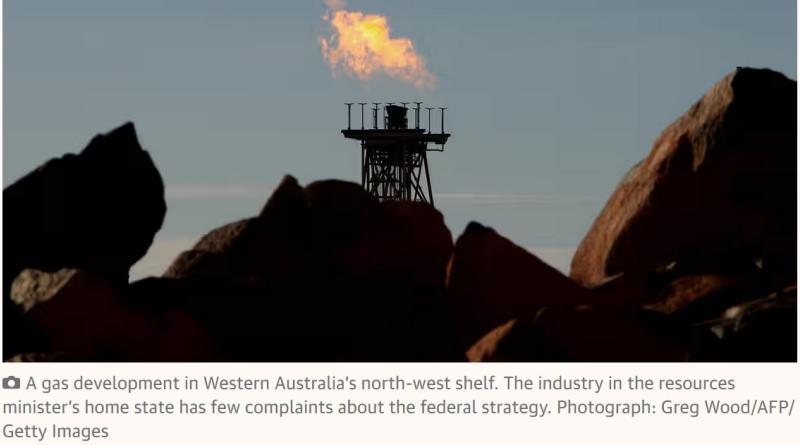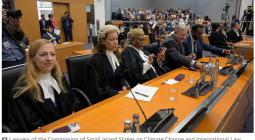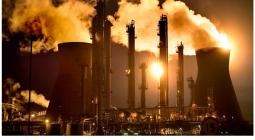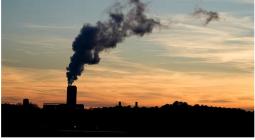Labor’s strategy is to reduce emissions from gas – but not if that means doing anything to cut its use

The bottom line of the “future gas strategy” isn’t what it might mean for the government’s political fortunes, despite what Labor pollsters and political commentators might argue.
It’s this: the gas industry, one of Australia’s biggest greenhouse gas polluters, is getting what it wants. What it wants, in simple terms, is government approval to make multibillion-dollar investments in new gas reservoirs that will lead to billions of tonnes of emissions.
The strategy’s central claim adopts language used by the industry. It says gas is an important part of the transition to net zero emissions, and that Australia will need new sources to meet demand “to 2050 and beyond”. It acknowledges that gas use needs to be reduced but offers nothing concrete in its list of “immediate actions” to make that happen.
This is consistent with the industry’s approach – concede the scientific evidence and commit to change but also push for as much development as possible while arguing gas can be a climate solution.
The reality is natural gas is a potent fossil fuel. It releases roughly half the emissions of coal when burned – a significant amount of pollution – and its impact on the climate is greater when leaks of methane, a powerful greenhouse gas, are factored in.
Gas was the biggest driver of the global growth in greenhouse emissions in the past decade. Australia is a significant player in this – 80% of the gas extracted here is shipped and burned overseas.
Gas production and use is responsible for about a quarter of the climate pollution released in Australia. It’s part of the problem, and has a real-world impact in contributing to worsening extreme events that devastate nature, lives and livelihoods.
The strategy acknowledges this. Madeleine King, the minister for resources and northern Australia, says in her introductory comments: “Greenhouse gas emissions associated with gas must sharply decline and where gas use cannot be reduced, emissions must be increasingly abated and offset.”
An analytical report released with the strategy talks about the “significant gap” between where Australia and the world are headed based on policy and industry action, and where we need to be for gas demand to be consistent with reaching net zero emissions by 2050.
The clear message is: we are not on track to meet the country’s legislated climate target.
You would think this might set off alarm bells. But rather than tackle how best to fairly and affordably minimise gas use in the decades ahead, a subject on which there has already been a stack of research and analysis, the strategy is most interested in what Australia should do to meet demand for gas from households and businesses at home and in the country’s trading partners Japan and South Korea.
It says that means accessing new sources, including potentially opening the Scarborough basin in Western Australia, Narrabri in New South Wales and the Northern Territory’s Beetaloo Basin.
The strategy assumes demand for gas will fall as the world transitions to cleaner practice and includes forecasts of what that might look like under different scenarios. But policies that could lead to a reduction in gas use, or avoid opening up new basins? That’s largely treated as a problem for another day, or another department.
There is an emphasis on not upsetting or forcing change on anyone who wants gas. Households “will continue to have a choice over how their energy needs are met”. Australia will “remain a reliable trading partner for energy, including liquefied natural gas”.
Fair enough, to a point. Australia becoming an unreliable trading partner won’t help if customers in north Asia just buy gas from someone else. And we have seen that voters will reject climate policies, such as Labor’s former carbon pricing scheme, if they believe they have been imposed on them unfairly. What’s missing are the policies and urgency that could help gas users here and overseas move on to cleaner energy sources as rapidly as possible.
A future gas strategy in a climate crisis could have focused on how the government might use diplomacy to help its partners to move away from gas and towards investing in potential Australian green energy exports. At home, it could have set out new plans to electrify homes and businesses so they are less reliant on gas for cooking and heating, given that there are cleaner and healthier options available.
Instead, we have a document that follows the now familiar government and industry pattern of supporting a far-off net zero emissions commitment but not the hard decisions necessary to reach it.
Other than the gas industry, the short-term winners from the strategy include Japanese interests that have lobbied for no change and seem to be drifting away from their climate commitments, and the vocal and gas-hooked WA Labor government. King is from WA and the strategy’s key messages seem particularly aimed at her home state.
The government will have another chance to address emissions from gas this year, when it releases decarbonisation plans for six sectors of the economy. They are being developed by the climate change minister, Chris Bowen, and his department, not King and the industry department.
Those wanting meaningful action had better hope they are less easily swayed by self-interested arguments.





